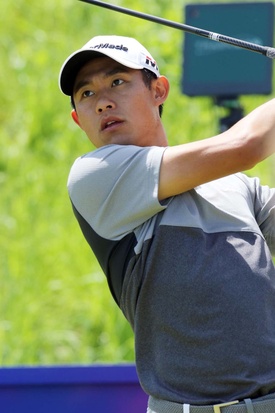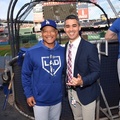Japan’s Hideki Matsuyama’s recent capturing of the Master’s Golf Championship at the venerable Augusta Country Club in Georgia is one of the greatest individual achievements for an athlete from Japan. What’s interesting for me is that while I was happy for Matsuyama, his victory was not as impactful as previous Japanese sports achievements once were to me. The reason in this case is Collin Morikawa and a new generation of Japanese American athletes.
First, Morikawa is a young professional golfer whose father Blaine’s family has roots in Hawaii. Collin, whose mother is Chinese American, embodies a certain profile of the Yonsei generation today. He grew up in La Canada, CA and with the help of his long-time coach Rick Sessinghaus managed to navigate his way through junior golf to get a scholarship to attend UC Berkeley. Morikawa established himself on the PGA Tour in his rookie year in 2019 by winning the Barracuda Championship in Reno, ensuring his eligibility to enter most PGA tournaments.
But Morikawa built his reputation in 2020 by beating Justin Thomas in a play-off to win the Workday Charity Open and then jumped to another category by winning the PGA Championship at Harding Park, his first major. This year, Collin almost immediately won again with his victory at the WGC-Workday Championship at the Concession Golf Club in Florida. In less than three years, he has won four times including a major and has risen to No. 4 in the world rankings.
If Japan has waited a long time for its individual athletes to reach the top of their sports, we Japanese Americans have been hoping that someone from our extended community could compete at the upper echelons of professional sports for generations. In my years working at the Rafu Shimpo newspaper and at the Japanese American National Museum (JANM), I often wondered if that was even possible, given our community’s small population base in America.
In the 1970s and 1980s while working on the sports section at the Rafu, I would scan the sports pages of the Los Angeles Times, seeking athletes with Japanese names so I could write a short paragraph about them. When Lenn Sakata played for the Milwaukee Brewers and the Baltimore Orioles in the 1980s as a utility infielder, I would wish he would play more often. Arnold Morgado ran back kick-offs for the Kansas City Chiefs, but rarely had an impact on the games. A few JA golfers like Gail Hirata and David Ishii floated around the edges of the pro tours, but only individuals like me knew they existed.
In 2000, JANM organized the exhibition, More Than a Game: Sport in the Japanese American Community. There were many outstanding athletes highlighted, including skaters, swimmers, bowlers, and sprinters, but most of those highlighted were not household names. JANM did uncover Wataru Misaka, who played guard for the University of Utah during and after World War II, where his teams won the NCAA basketball title and the National Invitational Tournament (NIT) in New York City. Misaka was drafted by the New York Knickerbockers and while he barely played in 1947, he did become part of NBA history as the first person of color. But it took over 50 years for Wat to be recognized by the league and the rest of the country.

Because of our community’s lack of representation, I ended up following the successes and appearances of athletes from Japan, especially during my years at the Rafu Shimpo. It was like trying to share in the achievements of distant cousins. This was nothing new. I remember Akemi Kikumura Yano, the former President and CEO of JANM, once recalling how important it was for her family when Miss Japan won the Miss Universe competition in 1959. Of course, many more Issei were alive at that time and still felt a direct connection to Japan. But as Japanese Americans, our need for positive images and role models has often gone wanting so that some chose to identify with Japanese success.
For many Japanese Americans, however, our relationship with Japan has been complicated and even painful. Due to the racist attitudes of large segments of American society, my parents’ generation spent much of their lives being denied their status as citizens in the United States while constantly being thought as visiting foreigners. Many Nisei and Sansei purposely eschewed anything Japanese to avoid being thought as from another country.
But it is also true that the Japan often looked down on Japanese Americans, who often spoke in a childlike Meiji Era language, if at all. The lack of acceptance from both sides of their lives left many Japanese Americans with only their own families and communities as sources of support and inspiration. Which explains why I often heard from Nisei and older Sansei about the local JA sports stars that they grew up with.
Floyd Mori, the former California Assemblyman and one-time head of the Japanese American Citizens League, once told me that when he was growing up in Utah, his idol was Wat Misaka. Mori remembered listening to the University of Utah basketball games on the radio and following Misaka’s exploits. He said he fashioned his own basketball game after Wat’s. Unfortunately, there weren’t that many sports figures like Misaka for Japanese Americans to follow and even idolize.
Which brings us back to Morikawa. He has clearly exceeded my expectations, but not his own. Indeed, Morikawa embodies a new generation of Asian American athletes who are less inhibited, more openly confident in their abilities, and more willing to speak their minds. Naomi Osaka, who is a Japanese national, moved to the United States when she was three and is clearly culturally American. The winner of four major tennis tournaments already, her social consciousness is also on display as a young professional. She may play under Japan’s flag, but I claim her as a Japanese American.
After Collin turned professional, but before he had won a tournament, he was asked by Sports Illustrated if he thought he could win a PGA tournament: “Absolutely,” he replied. “I one hundred percent believe I can. I don’t know if other people do but I believe I can. I think if I put together four straight days of good golf, I definitely think I can win. I know I can shoot low scores out here. I’m very confident. If you can’t believe in yourself, you’re already five steps behind and in a big hole.”
Morikawa’s mental approach has been strengthened by Sessinghaus, who earned his Masters and Doctorate degrees in Applied Sports Psychology. Ultimately, Sessinghaus developed his PERFORM system which can be used in sports, business and life in which he trains his students to embrace the pressure of competition and to bounce back from adversity. Which explains how Morikawa avoided the usual pitfalls of young professionals, but quickly won a tournament in his first year and went on to make 22 consecutive cuts.
In some ways, Morikawa’s success has almost been seamless. I was frankly more used to the struggle that Asian American athletes have endured. Basketball star Jeremy Lin famously was unrecruited by colleges out of high school and undrafted after playing at Harvard. He slept on his brother’s coach while seeking opportunities in the NBA. Playing for the Knicks, he only got a chance to play when most of the starters were injured. His dynamic set of games in 2011-2012 made him a media sensation, but also exposed the fact that Lin’s talent had been discounted because of his race.
Golf is different in that it doesn’t matter how your swing looks. Only your score matters. Morikawa wasn’t considered a top-line junior golfer until he was 16 when he shot four rounds in the 60s to win the 2013 Western Junior Open. “It put me on a bigger stage, got my name out there, helped my ranking rise,” he told the Cal school newspaper.
All signs point to Morikawa having a long and successful career. He is competitive, disciplined and talented. His early success has increased his profile to the point where he is doing national commercials for a bank. If continues to win, he probably will have a constant media presence. All of this is as it should be. It just wasn’t like that for Japanese Americans until now.

In fairness to Matsuyama, I was pleased he won the Masters. After building a big lead on the last day, he seemed to be stumbling by hitting the ball in the water on No. 15 and then bogeying the next hole. But he never lost his cool and what is clear is that no golfer in the world had more media scrutiny than poor Hideki.
As Washington Post sports columnist Thomas Boswell wrote, “For decades, I have watched the way the press from Japan obsessively covers its athletes, especially in golf and baseball, sports in which it shares a common, profound passion with America. You have to see it to believe it. It is adoration and judgment, celebrity and imminent disgrace, the highest honor and profound loss of face, pressed close against each other.”
Matsuyama’s wariness of the Japanese media is demonstrated by the fact he hid his marriage until his daughter was born. He has been a sports star since he won four times in his first year as a professional in Japan and became the first rookie to win the money title in 2013. Before winning the Masters, Matsuyama already had six victories on the American PGA Tour including winning Jack Nicklaus’ Memorial Tournament in 2014 and two World Golf Championship titles in 2017. He became the second-ranked golfer in the world that year, the highest ranking by a Japanese male.
By winning the Masters, his celebrity status has gone off the scale in Japan. Just recently, it was announced that Matsuyama will be the recipient of Japan’s Prime Minister’s Award, the second golfer to receive that recognition after Japanese star Ayako Okamoto. But I feel sympathy for him because his expectations have also jumped for the upcoming Summer Olympics. Having won a major, Matsuyama would be expected by many in his country to at least claim a medal, especially since the golf competition will be at the historic Kasumigaseki Country Club where he won one of his Asian Amateur Championships.
Which will be interesting, since Morikawa is currently among the American golfers currently qualified to represent the U.S. in the Olympics this summer. Given Collin’s consistency so far as a professional and his high ranking, I’m pretty confident he will be one of four American golfers to compete in this year’s Olympics.
I am already imagining the scenario in which Morikawa and Matsuyama are playing together in the final round and vying for the Gold Medal. Since all the spectators will be Japanese, it would be epic. If Morikawa shows the poise that has impressed the entire golf world, he could prevail. I would be glad if Matsuyama won a medal as well. But I would be ecstatic if Morikawa won the Gold.
Let’s see what happens.
© 2021 Chris Komai









